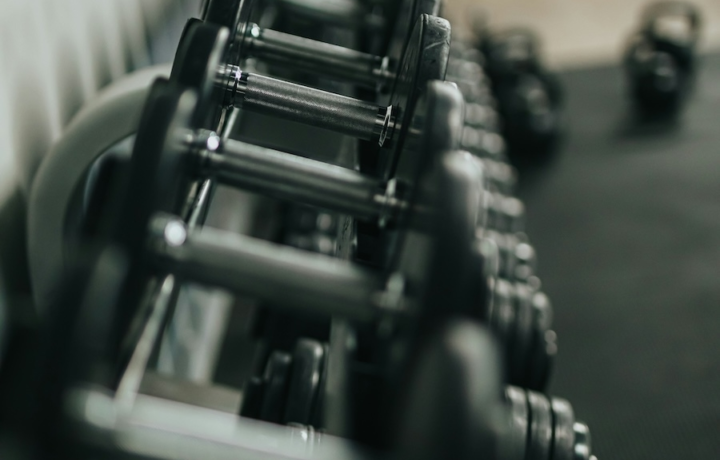Exercise
Bent Arm Lateral Raise

Bent Arm Lateral Raise
How to Perform
- Stand with your feet shoulder-width apart, knees slightly bent, and hold a dumbbell in each hand with palms facing inward at your sides.
- Bend your elbows to approximately 90 degrees and maintain this fixed angle throughout the entire movement.
- Brace your core and maintain a neutral spine position while slightly tilting your chest forward from the hips.
- Exhale as you raise both arms out to the sides, keeping the bent-arm position until your elbows reach shoulder height.
- At the top position, your upper arms should be parallel to the floor while maintaining the 90-degree bend in your elbows.
- Pause briefly at the top of the movement, focusing on squeezing your shoulder blades together.
- Inhale as you slowly lower the weights back to the starting position with controlled movement, maintaining tension in your shoulders.
- Keep your wrists neutral and aligned with your forearms throughout the entire exercise to prevent strain.
Important information
- Make sure your elbows stay at the same angle throughout the movement – avoid straightening your arms during the lift.
- Keep your shoulders down and away from your ears to properly engage the middle deltoids rather than the upper traps.
- If you feel neck strain, reduce the weight and focus on proper form before increasing resistance.
- Control the descent rather than letting gravity do the work – this increases time under tension for better muscle development.

Bent Arm Lateral Raise
Exercise Details
Primary Muscles
Muscle Groups
Mechanic
Risk Areas
Built for progress
Take the guesswork out of training
Create personalized AI-powered workout plans that evolve with you. Train smarter, track every rep and keep moving forward, one workout at a time.






The Bent Arm Lateral Raise stands as a dynamic isolation movement that has earned its place in shoulder-focused training regimens across gyms worldwide. This intermediate-level exercise specifically targets the side deltoids (lateral delts) as its primary muscle group, while also engaging the front deltoids as secondary movers. The bent arm position creates a mechanical advantage that allows for better muscle activation while potentially reducing strain on the shoulder joint. For bodybuilding enthusiasts, this variation offers a compelling alternative to traditional lateral raises. The slightly flexed elbow position can allow for heavier loading than straight-arm versions, making it particularly valuable for hypertrophy goals.
The concentrated tension on the medial deltoid heads helps create that coveted shoulder width and cap-like appearance that defines an aesthetic physique. From a strength perspective, the Bent Arm Lateral Raise serves as an excellent supplementary exercise to compound shoulder movements. By isolating the side delts, it addresses a muscle group that often lags in development for many lifters. Stronger lateral deltoids contribute to improved shoulder stability and can enhance performance in pressing movements like overhead presses and bench variations. What makes this exercise particularly effective is the constant tension maintained throughout the movement pattern. The bent arm position creates a favorable leverage situation while still challenging the deltoids through their full range of motion.
Many experienced lifters find this variation allows them to focus more intensely on the targeted muscles with reduced risk of momentum cheating. When incorporated into a well-designed training split, the Bent Arm Lateral Raise can serve as either a primary shoulder builder or as a finishing movement to thoroughly fatigue the deltoids after heavier compound work. Its versatility makes it suitable for both high-volume hypertrophy protocols and moderate-rep strength-endurance training, earning it a rightful place in any serious shoulder development arsenal.
FAQ - Bent Arm Lateral Raise
The Bent Arm Lateral Raise primarily targets the lateral deltoids (side shoulders), with secondary activation in the front deltoids and upper trapezius. The bent arm position allows for greater focus on the medial deltoid heads while reducing strain on the rotator cuff.
The bent arm position creates a mechanical advantage that often allows for heavier weight compared to straight-arm variations. This modification can reduce strain on the shoulder joint while maintaining tension on the lateral deltoids, making it particularly beneficial for those with shoulder discomfort during traditional raises.
Avoid arching your lower back or lifting your buttocks off the seat when pressing heavier weights. Keep your core braced, maintain contact with the backrest throughout the movement, and don't lock out your elbows at the top position to maintain tension on the deltoids.
Choose a weight that allows you to perform 10-15 controlled repetitions with proper form. You should feel your lateral deltoids working, but not so heavy that you compensate with body momentum or lose the mind-muscle connection. Most lifters will use lighter weights than they do for pressing movements.
Perform this exercise 1-2 times weekly, either as a primary shoulder builder on dedicated deltoid days or as a finishing movement after compound exercises like overhead presses. For hypertrophy, aim for 3-4 sets of 10-15 reps with controlled tempos, focusing on the contraction at the top of each repetition.






